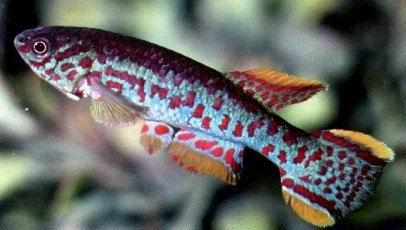Killifish - Diapteron cyanostictum
Gabon Jewelfish, Gabon Jewelfish Killifish Scientific Name: Diapteron cyanostictum
Sat, 5th July, 2025 - 9:40 pm GMT
Sponsor Ads:

Alternative Name
Gabon Jewelfish, Gabon Jewelfish Killifish Scientific Name: Diapteron cyanostictumBasic Info
The Diapteron genus are small killies seldom reaching more than an inch long, Diapteron cyanostictum is no exception. They are relatively small fish, but what they lack in size they more than make up for in appearance. Diapteron cyanostictum are quite beautiful. Their bodies are mostly brown and red, with iridescent spots of a blue to green tint. The spots can give them the appearance of shimmering and may be why some people refer to them as "Jewel Killifish". Male Diapteron cyanostictum may be distinguished from females by their large dorsal and anal fins. Their caudal fin of the male also has several long rays. The female's fins are not as large.
Health
Diapteron cyanostictum is generally not suited for beginners due to its difficulty to keep. They require cool water near 65 degrees F. The pH level of the water should be acidic, with a range of 5.1 to 6.2. A little salt may be added to their water, as well. Diapteron cyanostictum should be fed mosquito larvae, cyclops, small tubifex worms, brine shrimp and grindal worms. Breeding Diapteron cyanostictum is considered one of the most difficult killies to breed in captivity. In the wild, Diapteron cyanostictum is an egg scatterer. They require at least two to three weeks' incubation. If you are breeding in captivity it is generally recommended that the parents be removed, as they may eat the young. Also, the fry have been known to cannibalize each other. Fry are very small and should be fed infusoria as their first food. Diapteron cyanostictum mature in roughly one year, and have an average lifespan of between three and fives years on average.Habitat
Fresh water fish - Most are found in the Iyindo River system.Behavior
Diapteron cyanostictum also known as the "Gabon Jewelfish" or "Jewel Killifish", is considered by some to be the most colorful and beautiful of all Killifish. Diapteron cyanostictum is one of the most difficult killifish to breed and care for in captivity and is generally not kept by beginners for this reason. It is a rather peaceful fish, and will go well into most communities. It will do best, however, if kept with its own kind. They should probably not be kept with over active, aggressive fish. If two males are kept together, they might occasionally spar. However, Diapteron cyanostictum will do nothing more than flare there fins and dance around, which can be quite entertaining. Diapteron cyanostictum will do best, if kept in an environment similar to their natural environment. Such a setup would have a peat substrate, and dense plant formations, and little to no artificial light. Killifish are generally not common in pet stores, and beginners should contact their local killifish societies or clubs for information on how to acquire these wonderful fish.Origin
West AfricaHistory
Diapteron cyanostictum is native to Africa. Like most killifish, enthusiasts will refer to this fish by its scientific name much more readily than by common names. This may be intimidating to those new to the hobby, but it is actually much easier to keep track of different fish by this method. With many animals common names are often misleading and used for several different species of animal. The use of the killifish's scientific name prevents this type of confusion.Common Foods
N/ASponsor Ads:
Great programmers learn how to program their tools, not just use them. -- Steve Yegge
Killifish - Diapteron cyanostictum
Coded by: BGID® | ALL RIGHTS RESERVED Copyright © 2000-2025
Disclaimer | Privacy | Report Errors / Contact | Credits








 Preparing For China. China is growing their military. China Military Technology - can it keep up with the US?
Preparing For China. China is growing their military. China Military Technology - can it keep up with the US?  versus
versus 

 versus
versus 
 This Thread is about the North Korean Military itself - the kind of army, navy, and air force they have.
This Thread is about the North Korean Military itself - the kind of army, navy, and air force they have. 
 versus
versus 
 versus
versus  versus
versus